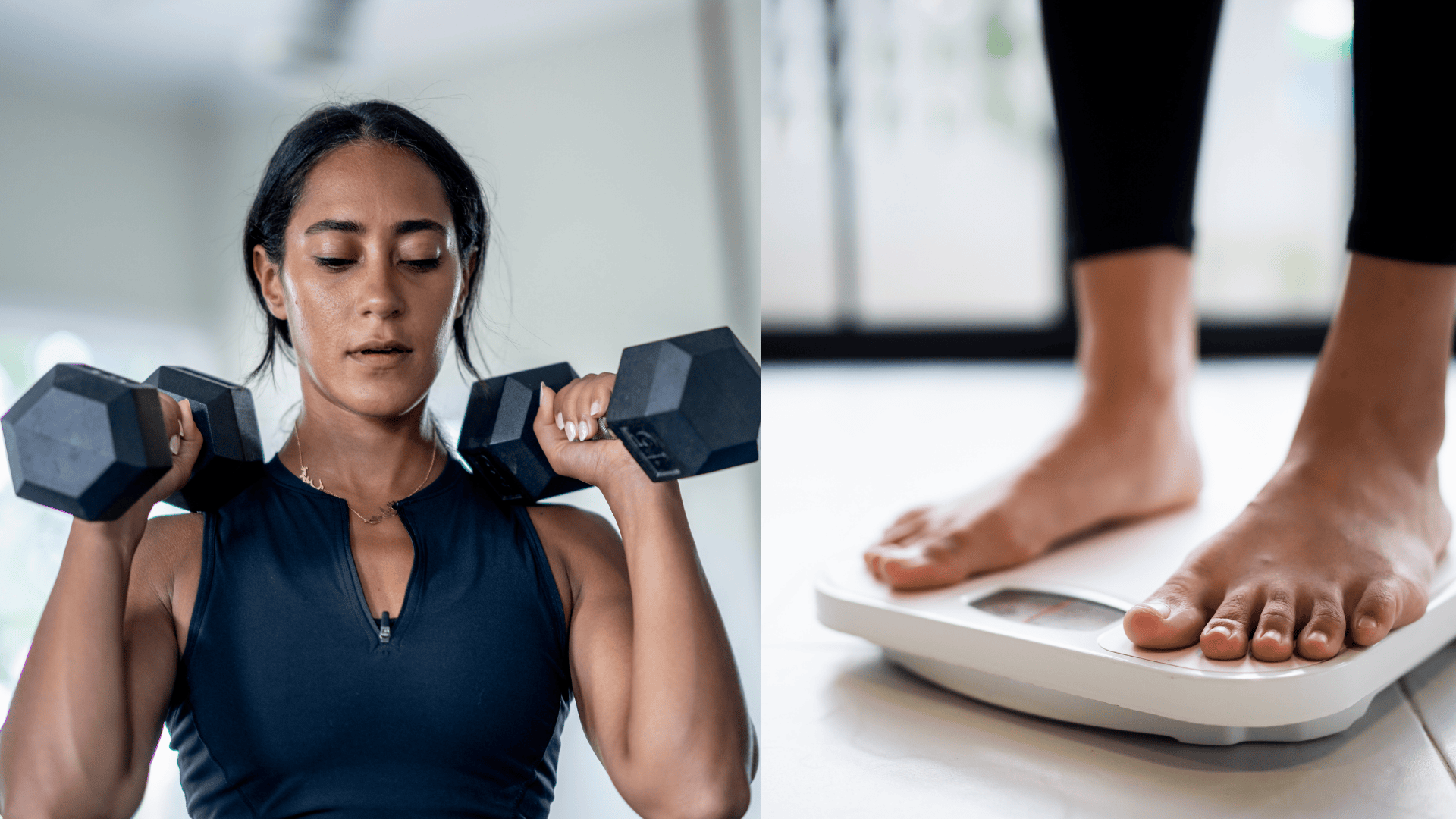Your clothes fit better. You feel stronger in the gym. Yet the scale hasn’t budged in weeks. Sound familiar?
Body recomposition creates this confusing scenario where your body changes while your weight stays the same. Most people panic and think their fitness plan isn’t working.
They’re wrong. When you lose fat and gain muscle simultaneously, traditional weight tracking becomes useless.
Your body is actually making incredible progress that standard scales can’t measure. This guide shows you exactly what signs of muscle growth and signs of fat loss to watch for instead.
Stop obsessing over weight numbers and start recognizing the real indicators that prove your body is changing for the better.
What is Body Recomposition?
Body recomposition refers to the process of losing fat while simultaneously gaining muscle.
Unlike traditional weight loss (which often results in the loss of both fat and muscle) or bulking (which gains both muscle and fat), body recomposition alters your body’s composition without significant scale changes.
This process works through a balanced approach of moderate calorie control, consistent strength training, and proper protein intake that boosts your metabolism.
Beginners, individuals returning to training after a break, and those who are overweight tend to see the best results because their bodies respond quickly to new muscle-building stimuli, while also having sufficient stored fat to lose simultaneously.
General Signs of Muscle Gain
Muscle growth is evident in strength, shape, and body changes that extend beyond the number on the scale.
1. Increased Strength
The clearest sign of muscle growth shows up in your gym performance. Your muscles adapt quickly to resistance training, becoming stronger and more capable.
You’ll notice yourself adding weight to the bar, completing extra reps, or finishing more sets with the same effort.
This strength improvement typically occurs within 2-4 weeks, indicating that your muscles are rebuilding stronger than before.
2. Improved Muscle Definition
Your muscles start looking more defined and feel firmer to the touch as protein synthesis increases. You’ll see better shape and contour in your arms, legs, and torso, even without losing significant fat.
The muscle fibers grow denser and more pronounced, creating visible changes in your physique. This firmness appears first in the muscles you train most often.
3. Stable or Slightly Higher Body Weight
Don’t panic if the scale stays the same or goes up slightly during body recomposition. Muscle tissue weighs more than fat tissue, so gaining muscle while losing fat can make weight changes appear less significant.
Your body composition improves dramatically even when total weight remains constant. Focus on how your clothes fit and how you look rather than the number on the scale.
4. Better Endurance
Your workout stamina improves noticeably as your muscles grow stronger and more efficient. You’ll finish training sessions with more energy left in the tank.
Recovery between sets gets faster, and post-workout fatigue decreases over time. Your muscles adapt to handle more volume and intensity without breaking down as quickly.
5. Body Measurements Expanding in Lean Areas
Take monthly measurements to track muscle growth in key areas, such as the biceps, chest, and thighs.
These areas will show gradual increases as muscle mass builds up underneath. Your shoulders may broaden, and your legs may get slightly bigger around the muscle areas. Meanwhile, your waist measurements often decrease as you lose belly fat simultaneously.
6. Soreness Shifts Over Time
Initial muscle soreness from new exercises fades as your body adapts to training. Instead of painful soreness lasting days, you’ll feel a satisfying muscle “pump” during and after workouts.
This pump feeling means blood flow to your muscles has improved, and they’re working more efficiently.
The soreness becomes less about damage and more about productive muscle stimulation.
7. Enhanced Posture and Confidence
Building muscle in your back, shoulders, and core naturally improves your posture throughout the day. You’ll stand taller and feel more stable during daily activities.
Stronger muscles support your spine better, reducing slouching and forward head positioning. This physical improvement often boosts confidence and makes you feel more capable in your body.
General Signs of Fat Loss
Fat loss isn’t always shown on the scale; instead, look for visual, physical, and measurement changes in your body.
1. Looser Clothing
Your clothes become the most honest indicator of how to know you’re losing fat during body recomposition.
Pants feel looser around the waist, shirts hang differently on your torso, and sleeves may feel roomier.
Fat takes up more space than muscle, so losing fat while gaining muscle creates noticeable changes in fit. This is one of the clearest signs of fat loss without weight change that you can trust over the scale.
2. Reduced Waist Circumference
Your waistline shrinks as belly fat decreases, even when total body weight remains stable. Measure around your natural waist (the smallest part of your torso) monthly to track this change.
Most people store excess fat in their midsection first, so this area often shows the earliest signs of fat loss. A smaller waist measurement indicates that fat loss is occurring, regardless of what the scale shows.
3. Visible Veins and Muscle Striations
You’ll start seeing veins in your arms, hands, and legs more clearly as the fat layer above them thins out.
Muscle striations (the lines that show muscle fiber direction) become visible in areas like your shoulders and legs.
This increased vascularity happens because less fat sits between your skin and the underlying structures. It’s a reliable sign that your body fat percentage is dropping even without weight loss.
4. Face and Jawline Looking Leaner
Your face often shows fat loss before other body areas, making your jawline more defined and cheekbones more prominent.
The area under your chin may tighten, and your face may appear less puffy overall. Friends and family often notice these facial changes before you do.
Progress photos of your face can reveal subtle yet significant fat loss that the scale may not capture.
Men vs Women: Body Recomposition Differences
Men and women experience body recomposition differently due to hormonal differences, variations in fat distribution, and varying muscle growth rates.
| Aspect | Women | Men |
|---|---|---|
| Muscle Gain | Toned arms, firm glutes, steady definition. | Broader shoulders, chest growth, faster abs. |
| Fat Loss | Slimmer waist, reduced belly fat, and slower in the hips and thighs. | Shrinking love handles, less belly fat, faster upper-body changes. |
| Hormones | Estrogen tends to store fat in the hips and thighs. Progress appears slower. | Testosterone boosts muscle growth and speeds fat loss. |
| Timeline | Steady but slower visible changes. | Faster visible results with training and diet. |
How to Track Your Progress Effectively?
Tracking body recomposition progress requires multiple measurement methods beyond just using a scale.
Weekly progress photos taken in the same lighting and poses reveal visual changes the mirror can’t show you day-to-day.
Monthly measurements of your waist, arms, chest, and thighs capture changes in size as muscle grows and fat shrinks.
Gym performance logs, which track weights, reps, and sets, prove that your strength is increasing over time.
Energy levels and recovery improvements indicate that your body is adapting positively to changes in training and nutrition.
Conclusion
Body recomposition takes patience, but the results speak louder than any scale reading.
Your strength improvements, better-fitting clothes, and increased muscle definition prove your hard work is paying off.
The scale may not move for months, yet your body undergoes changes that matter more than the numbers on the scale.
Focus on taking progress photos, measuring key body areas, and tracking your gym performance instead. These signs of fat loss and muscle gain tell the real story of your fitness success.
Ready to start your conversion? Begin strength training three times per week, eat adequate protein, and track your non-scale victories. Your body is changing; now you know how to see it.
Looking for more wellness tips & strategies? Browse Recovery & Wellness for evidence-based relief tips











